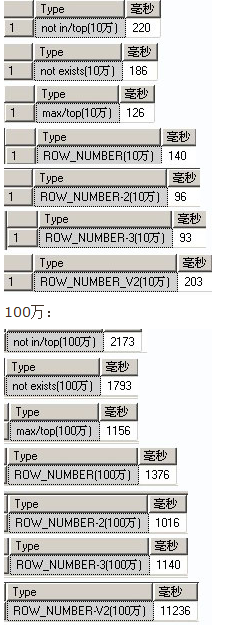sql分页查询几种写法,sql分页几种写法
关于SQL语句分页,网上也有很多,我贴一部分过来,并且总结自己已知的分页到下面,方便日后查阅
1.创建测试环境,(插入100万条数据大概耗时5分钟)。
create database DBTest use DBTest --创建测试表 create table pagetest ( id int identity(1,1) not null, col01 int null, col02 nvarchar(50) null, col03 datetime null ) --1万记录集 declare @i int set @i=0 while(@i<10000) begin insert into pagetest select cast(floor(rand()*10000) as int),left(newid(),10),getdate() set @i=@i+1 end2.几种典型的分页sql,下面例子是每页50条,198*50=9900,取第199页数据。
--写法1,not in/top
--写法2,not exists
--写法3,max/top
--写法4,row_number()
--写法5,在csdn上一帖子看到的,row_number() 变体,不基于已有字段产生记录序号,先按条件筛选以及排好序,再在结果集上给一常量列用于产生记录序号
3.分别在1万,10万(取1990页),100(取19900页)记录集下测试。
测试sql:
declare @begin_date datetime declare @end_date datetime select @begin_date = getdate() <.....YOUR CODE.....> select @end_date = getdate() select datediff(ms,@begin_date,@end_date) as '毫秒'1万:基本感觉不到差异。
10万:

4.结论:
1.max/top,ROW_NUMBER()都是比较不错的分页方法。相比ROW_NUMBER()只支持sql2005及以上版本,max/top有更好的可移植性,能同时适用于sql2000,access。
2.not exists感觉是要比not in效率高一点点。
3.ROW_NUMBER()的3种不同写法效率看起来差不多。
4.ROW_NUMBER() 的变体基于我这个测试效率实在不好。原帖在这里
PS.上面的分页排序都是基于自增字段id。测试环境还提供了int,nvarchar,datetime类型字段,也可以试试。不过对于非主键没索引的大数据量排序效率应该是很不理想的。
5.简单将ROWNUMBER,max/top的方式封装到存储过程。
ROWNUMBER(): ALTER PROCEDURE [dbo].[Proc_SqlPageByRownumber] ( @tbName VARCHAR(255), --表名 @tbGetFields VARCHAR(1000)= '*',--返回字段 @OrderfldName VARCHAR(255), --排序的字段名 @PageSize INT=20, --页尺寸 @PageIndex INT=1, --页码 @OrderType bit = 0, --0升序,非0降序 @strWhere VARCHAR(1000)='', --查询条件 --@TotalCount INT OUTPUT --返回总记录数 ) AS -- ============================================= -- Author: allen (liyuxin) -- Create date: 2012-03-30 -- Description: 分页存储过程(支持多表连接查询) -- Modify [1]: 2012-03-30 -- ============================================= BEGIN DECLARE @strSql VARCHAR(5000) --主语句 DECLARE @strSqlCount NVARCHAR(500)--查询记录总数主语句 DECLARE @strOrder VARCHAR(300) -- 排序类型 --------------总记录数--------------- IF ISNULL(@strWhere,'') <>'' SET @strSqlCount='Select @TotalCout=count(*) from ' + @tbName + ' where 1=1 '+ @strWhere ELSE SET @strSqlCount='Select @TotalCout=count(*) from ' + @tbName --exec sp_executesql @strSqlCount,N'@TotalCout int output',@TotalCount output --------------分页------------ IF @PageIndex <= 0 SET @PageIndex = 1 IF(@OrderType<>0) SET @strOrder=' ORDER BY '+@OrderfldName+' DESC ' ELSE SET @strOrder=' ORDER BY '+@OrderfldName+' ASC ' SET @strSql='SELECT * FROM (SELECT ROW_NUMBER() OVER('+@strOrder+') RowNo,'+ @tbGetFields+' FROM ' + @tbName + ' WHERE 1=1 ' + @strWhere+' ) tb WHERE tb.RowNo BETWEEN '+str((@PageIndex-1)*@PageSize+1)+' AND ' +str(@PageIndex*@PageSize) exec(@strSql) SELECT @TotalCount ENDpublic static SqlParameter MakeInParam(string ParamName, SqlDbType DbType, Int32 Size, object Value) { return MakeParam(ParamName, DbType,Size, ParameterDirection.Input, Value); } public static SqlParameter MakeOutParam(string ParamName, SqlDbType DbType) { return MakeParam(ParamName, DbType, 0, ParameterDirection.Output, null); } public static SqlParameter MakeParam(string ParamName, SqlDbType DbType, Int32 Size, ParameterDirection Direction, object Value) { SqlParameter param; if (Size > 0) param = new SqlParameter(ParamName, DbType, Size); else param = new SqlParameter(ParamName, DbType); param.Direction = Direction; if (!(Direction == ParameterDirection.Output && Value == null)) param.Value = Value; return param; } /// <summary> /// 分页获取数据列表及总行数 /// </summary> /// <param>表名</param> /// <param>返回字段</param> /// <param>排序的字段名</param> /// <param>页尺寸</param> /// <param>页码</param> /// <param>false升序,true降序</param> /// <param>查询条件</param> public static DataSet GetPageList(string tbName, string tbGetFields, string OrderFldName, int PageSize, int PageIndex, string strWhere) { SqlParameter[] parameters = { MakeInParam("@tbName",SqlDbType.VarChar,255,tbName), MakeInParam("@tbGetFields",SqlDbType.VarChar,1000,tbGetFields), MakeInParam("@OrderfldName",SqlDbType.VarChar,255,OrderFldName), MakeInParam("@PageSize",SqlDbType.Int,0,PageSize), MakeInParam("@PageIndex",SqlDbType.Int,0,PageIndex), MakeInParam("@OrderType",SqlDbType.Bit,0,OrderType), MakeInParam("@strWhere",SqlDbType.VarChar,1000,strWhere), // MakeOutParam("@TotalCount",SqlDbType.Int) }; return RunProcedure("Proc_SqlPageByRownumber", parameters, "ds"); }
调用:
public DataTable GetList(string tbName, string tbGetFields, string OrderFldName, int PageSize, int PageIndex, string strWhere, ref int TotalCount) { DataSet ds = dal.GetList(tbName, tbGetFields, OrderFldName, PageSize, PageIndex, strWhere); TotalCount = Convert.ToInt32(ds.Tables[1].Rows[0][0]); return ds.Tables[0]; }注意:多表连接时需注意的地方
1.必填项:tbName,OrderfldName,tbGetFields
2.实例:
tbName =“UserInfo u INNER JOIN Department d ON u.DepID=d.ID” tbGetFields=“u.ID AS UserID,u.Name,u.Sex,d.ID AS DepID,d.DefName” OrderfldName=“u.ID,ASC|u.Name,DESC” (格式:Name,ASC|ID,DESC) strWhere:每个条件前必须添加 AND (例如:AND UserInfo.DepID=1 )Max/top:(简单写了下,需要满足主键字段名称就是"id")
create proc [dbo].[spSqlPageByMaxTop] @tbName varchar(255), --表名 @tbFields varchar(1000), --返回字段 @PageSize int, --页尺寸 @PageIndex int, --页码 @strWhere varchar(1000), --查询条件 @StrOrder varchar(255), --排序条件 @Total int output --返回总记录数 as declare @strSql varchar(5000) --主语句 declare @strSqlCount nvarchar(500)--查询记录总数主语句 --------------总记录数--------------- if @strWhere !='' begin set @strSqlCount='Select @TotalCout=count(*) from ' + @tbName + ' where '+ @strWhere end else begin set @strSqlCount='Select @TotalCout=count(*) from ' + @tbName end --------------分页------------ if @PageIndex <= 0 begin set @PageIndex = 1 end set @strSql='select top '+str(@PageSize)+' * from ' + @tbName + ' where id>(select max(id) from (select top '+str((@PageIndex-1)*@PageSize)+' id from ' + @tbName + ''+@strOrder+')a) '+@strOrder+'' exec sp_executesql @strSqlCount,N'@TotalCout int output',@Total output exec(@strSql)园子里搜到Max/top这么一个版本,看起来很强大,
调用:
declare @count int --exec [dbo].[spSqlPageByRownumber]'pagetest','*',50,20,'','order by id asc',@count output exec [dbo].[spSqlPageByMaxTop]'pagetest','*',50,20,'','order by id asc',@count output select @count以上就是本文针对sql分页查询几种写法的全部内容,希望大家喜欢。
